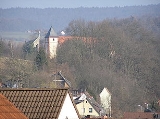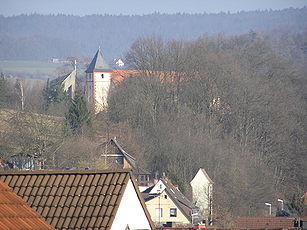
Sailauf
Encyclopedia

Aschaffenburg (district)
Aschaffenburg is a district in Bavaria, Germany. It is bounded by the districts of Darmstadt-Dieburg, Offenbach, Main-Kinzig , the districts Main-Spessart and Miltenberg, and the town of Aschaffenburg....
in the Regierungsbezirk
Regierungsbezirk
In Germany, a Government District, in German: Regierungsbezirk – is a subdivision of certain federal states .They are above the Kreise, Landkreise, and kreisfreie Städte...
of Lower Franconia
Lower Franconia
Lower Franconia is one of the three administrative regions of Franconia in Bavaria , Germany ....
(Unterfranken) in Bavaria
Bavaria
Bavaria, formally the Free State of Bavaria is a state of Germany, located in the southeast of Germany. With an area of , it is the largest state by area, forming almost 20% of the total land area of Germany...
, Germany
Germany
Germany , officially the Federal Republic of Germany , is a federal parliamentary republic in Europe. The country consists of 16 states while the capital and largest city is Berlin. Germany covers an area of 357,021 km2 and has a largely temperate seasonal climate...
.
Location
The community lies in the VorspessartSpessart
The Spessart is a low mountain range in northwestern Bavaria and southern Hesse, Germany. It is bordered on three sides by the Main River. The two most important towns located at the foot of the Spessart are Aschaffenburg and Würzburg....
(range) near Aschaffenburg
Aschaffenburg
Aschaffenburg is a city in northwest Bavaria, Germany. The town of Aschaffenburg is not considered part of the district of Aschaffenburg, but is the administrative seat.Aschaffenburg is known as the Tor zum Spessart or "gate to the Spessart"...
and is among the Vorspessart’s oldest settled centres. The outlying centre of Eichenberg belongs to the community.
History
As early as 1089, the original church in the upper AschaffAschaff
The Aschaff is a river in the northern Spessart in Bavaria, Germany.It is a right tributary of the Main and is 21,4 km long. It begins at the confluence of Autenbach and Kleinaschaff in Waldaschaff. Loosely translated the name Aschaff means Eschenwasser. The largest tributary is the Laufach...
valley stood here.
In 1189, the lordly estate of Sigilovf(e), meaning “Glistening Brook”, and out of whose name arose the placename Sailauf, had its first documentary mention. In the 13th century, Sailauf was for a short time ruled by the Counts of Rieneck, who built the castle “Landesere” on the nearby Gräfenberg. In 1265, the Elector of Mainz, Werner von Eppstein built the hunting castle “castrum vivarium”, which was later named Weyberhof. While the Plague raged in Europe in 1349, the Vorspessart was all but empty of people. Newcomers later came to Sailauf from the Steigerwald. In 1552, Weyberhof Castle was destroyed.
In the Thirty Years' War
Thirty Years' War
The Thirty Years' War was fought primarily in what is now Germany, and at various points involved most countries in Europe. It was one of the most destructive conflicts in European history....
(1618–1648), Sailauf was almost utterly destroyed. In 1789, Saint Vitus’s Church (Sankt-Vitus-Kirche) was built above Sailauf, becoming what is believed to be the fourth church built on this spot. In 1803, the Elector’s lordship over the Vorspessart ended and in 1814, Aschaffenburg and its surrounding area passed to Bavaria. Since 1972, the outlying community of Eichenberg has belonged to Sailauf.
Community council
The council is made up of 17 council members, counting the mayor.| CSU Christian Social Union of Bavaria The Christian Social Union in Bavaria is a Christian democratic and conservative political party in Germany. It operates only in the state of Bavaria, while its sister party, the Christian Democratic Union , operates in the other 15 states of Germany... |
SPD Social Democratic Party of Germany The Social Democratic Party of Germany is a social-democratic political party in Germany... |
Freie Wählergemeinschaft Eichenberg | Total | |
| 2008 | 6 | 7 | 4 | 17 seats |
(as at 6 March 2008)
Coat of arms
The community’s armsCoat of arms
A coat of arms is a unique heraldic design on a shield or escutcheon or on a surcoat or tabard used to cover and protect armour and to identify the wearer. Thus the term is often stated as "coat-armour", because it was anciently displayed on the front of a coat of cloth...
might be described thus: Argent a bend sinister gules surmounted by a wheel spoked of six of the first, in chief dexter a bend sinister wavy azure, in base sinister an oak sprig with a leaf in bend sinister and an acorn in bend vert.
The German blazon specifies a silver wheel (belegt mit einem sechsspeichigen silbernen Rad), although the example shown here has a golden wheel. This wheel – the Wheel of Mainz
Wheel of Mainz
thumb|150px|version until 1992thumb|150px|version from 1992 - 2008thumb|150px|version from 2008The Wheel of Mainz or Mainzer Rad, in German, was the coat of arms of the Archbishopric of Mainz and thus also of the Electorate of Mainz , in Rhineland-Palatinate, Germany. It consists of a silver wheel...
– and the bend sinister – the slanted stripe, so called because at the top it begins on the sinister (armsbearer’s left, viewer’s right) side – stand for the community’s history, lasting from the 13th century until 1803, as an Electoral Mainz
Archbishopric of Mainz
The Archbishopric of Mainz or Electorate of Mainz was an influential ecclesiastic and secular prince-bishopric in the Holy Roman Empire between 780–82 and 1802. In the Roman Catholic Church hierarchy, the Archbishop of Mainz was the primas Germaniae, the substitute of the Pope north of the Alps...
holding; the tincture
Tincture (heraldry)
In heraldry, tinctures are the colours used to emblazon a coat of arms. These can be divided into several categories including light tinctures called metals, dark tinctures called colours, nonstandard colours called stains, furs, and "proper". A charge tinctured proper is coloured as it would be...
s gules and argent (red and silver) were Mainz’s colours. The blue wavy bend sinister stands for the community’s location at the forks of the Sailauf and the Steinbach, two local brooks. The green oak twig with the acorn refers to the Spessart range, which is thickly wooded with oaks, and in which the community lies.
The arms were conferred on 21 March 1969.
Culture and social life
Sailauf has a variety of clubs; nationally known are the Bavarian Red Cross Juniors.Two events that are unique to Sailauf are the yearly Sailaufer Knoblauchfest (“Sailauf Garlic Festival”) and the Tsukahara-Festival.
Among social institutions there are a kindergarten
Kindergarten
A kindergarten is a preschool educational institution for children. The term was created by Friedrich Fröbel for the play and activity institute that he created in 1837 in Bad Blankenburg as a social experience for children for their transition from home to school...
and a primary school. The community is a member of the association of municipal music schools.
Famous people
- Felix MagathFelix MagathWolfgang-Felix Magath is a former German football central midfielder and current manager of VfL Wolfsburg.-Playing career:...
, footballer and trainer - Bernhard LippertBernhard LippertBernhard Lippert is a German football manager.Lippert worked between 1994 and 1997 as manager of the Eintracht Frankfurt reserve team, Eintracht Frankfurt Amateure. In 1997 he was promoted as he became assistant manager of the first squad he worked there until 2000. Between December 9 and December...
, football trainer - Theodor BergmannTheodor BergmannTheodor Bergmann was a German businessman and industrialist best remembered for the various revolutionary firearms his companies released. Like many entrepreneurs of the era, his activity was centered on bicycles and the nascent automobile...
, entrepreneur and carmaker
Further reading
- Rudolf J. Lippert: Sailauf und Eichenberg im Lichte der Überlieferung. self-published, Obertshausen 2003
- Werner Konrad, Ferdl Kraus, Waldemar Lippert: Sailauf-Eichenberg. In Bildern um die Jahrtausendwende, Geiger-Verlag 2000
- Sailauf Eichenberg. Bilder aus über 100 Jahren dörflicher Vergangenheit, by Ferdinand Kraus (foreword), Fred Maier (foreword), Karl Strom (foreword), Gerhard Steigerwald (foreword), Maria Reinhardt, Herta Hubertus, Bruno Eisert, Gottfried Baumann, Geiger-Verlag 1996

